Spring rains are falling in our region at least and we are being treated to spring flowers blooming, new leaves unfurling and vegetation generally greening up. So here is a quick share of some of the spring flowers gracing our garden.
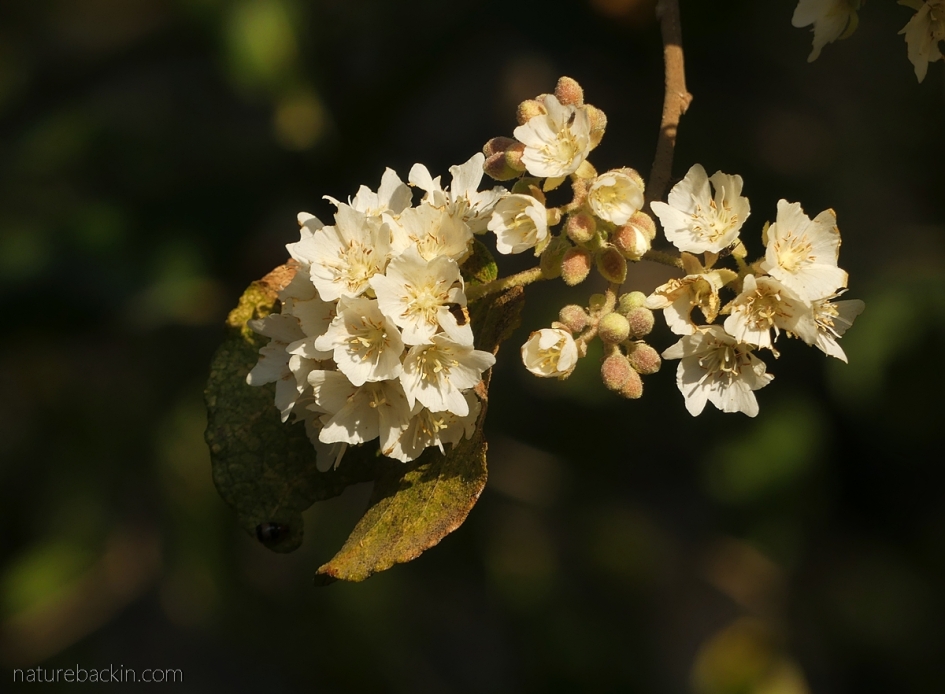
The deciduous small tree, the wild pear (Dombeya rotundifolia) starts producing its nectar-rich flowers as a harbinger of spring in late July into early August.
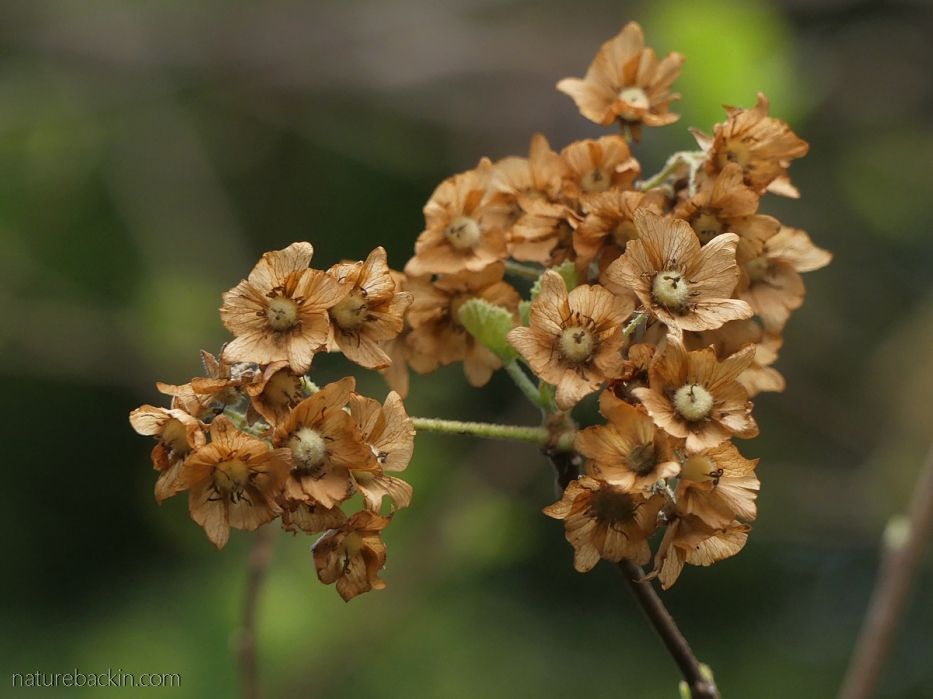
And this is what the flowers look like now at the end of September – the petals are dry and remaining on the stem surrounding the fruits. When the seeds eventually fall the dry petals help float the seeds off through the air.
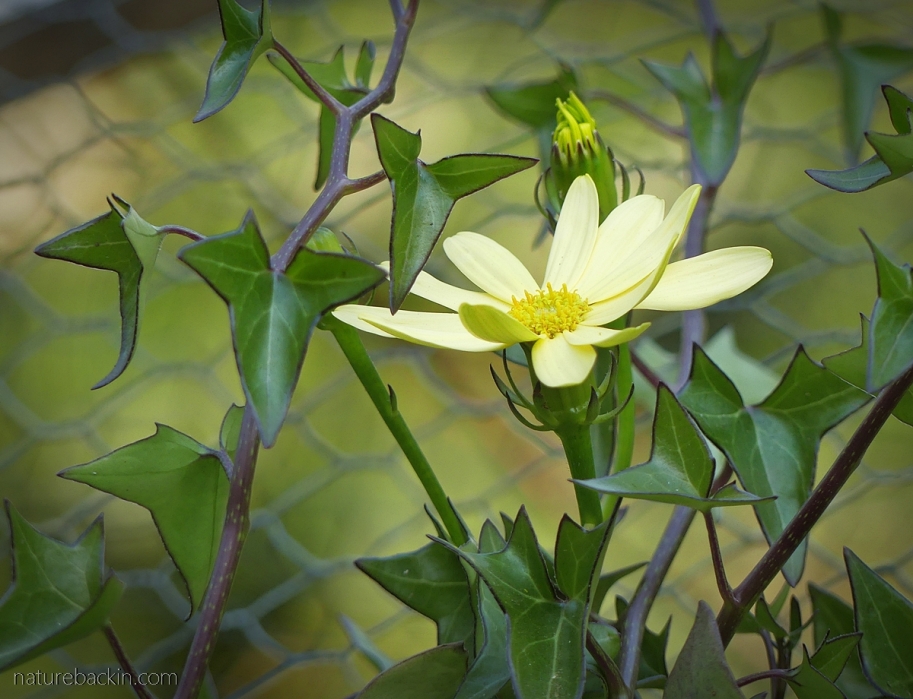
A perfect climber for a fence or to cover a tree stump, is the flowering ivy, Senecio macroglossus. It will also creep across the ground. In the wild it often grows on forest margins but also in sandy and rocky places. I have always known it as the Natal ivy but it is also referred to as the Cape ivy. Being a Senecio it is not an ivy at all but a member of the Daisy (Asteraceae) Family. Senecio is the largest genus of flowering plants with about 2000 species worldwide and about 300 native to South Africa.
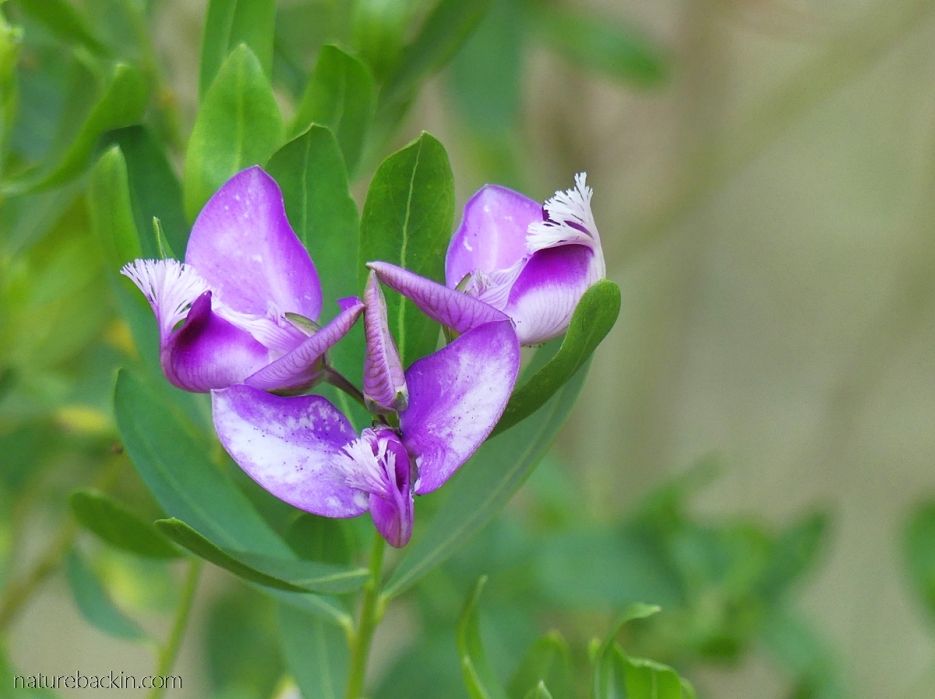
The September bush (Polygala myrtifolia) is a free-flowering shrubby tree that self-seeds liberally around the garden. A member of the Milkwort (Polygalaceae) Family, interestingly ‘poly’ means ‘much’ and ‘gala’ means ‘milk’ as plants were thought to increase the production of milk in cows. The three flowers in the photo are showing their feathery crests. Carpenter bees especially are attracted to the flowers.
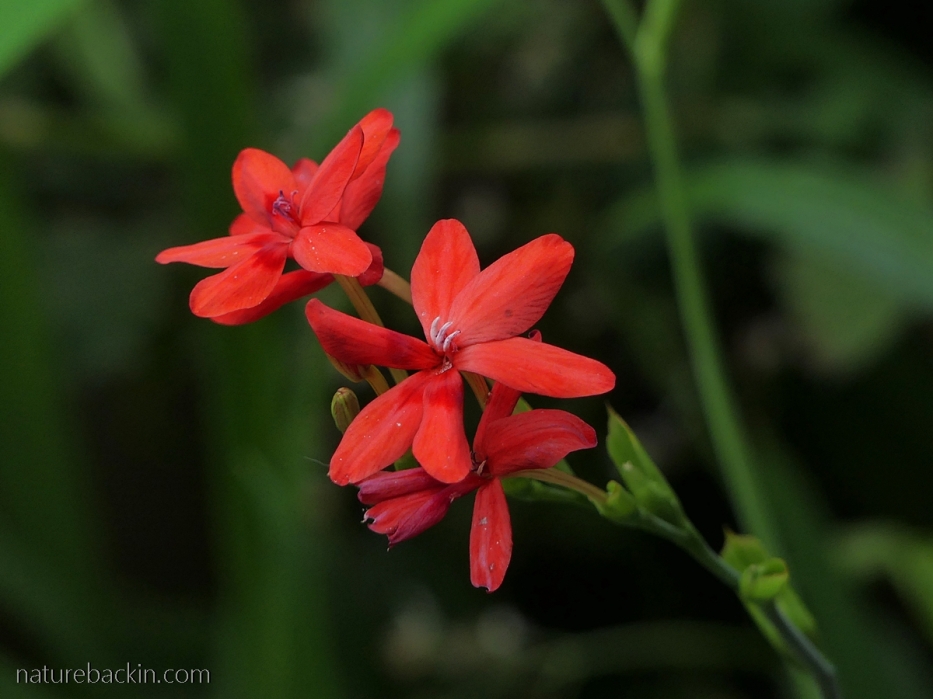
The diminutive Freesia laxa, also known as small red iris, woodland painted petals or flower grass, dies down in the winter and remerges to flower in the spring. Sometimes a wild porcupine squeezes under our back gate to forage in the garden seeking corms and bulbs. Last year a porcupine favoured the Freesia laxa, digging up and eating corms, but in the process seemed to distribute some of those it missed, so this year the flowers are popping up also in new places.
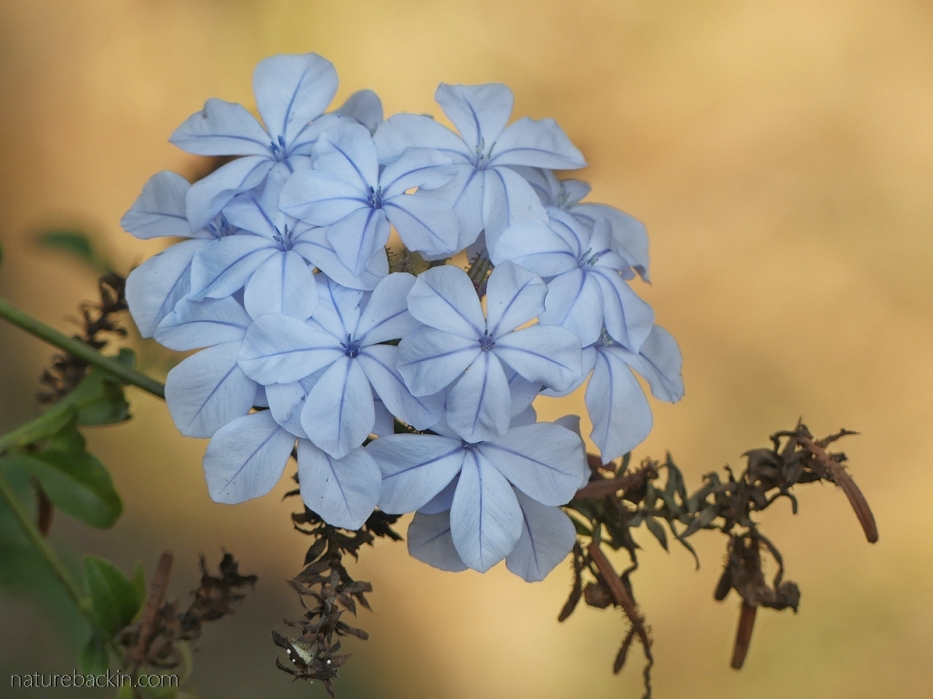
Plumbago (Plumbago auriculata) is an old favourite with old-fashioned gardening connotations, at least for me. Athough still in flower now in our garden, the photograph was taken two months ago against a background of dry leaves. Plumbago auriculata is a member of the Plumbago/Leadwort (Plumbaginaceae) Family. ‘Plumban’ in the name of both the Family and the genus means ‘lead’ and is thought to derive from the belief that some plumbago plants helped cure lead poisoning. There are 10 species in the plumbago genus worldwide with 5 occurring naturally in South Africa.
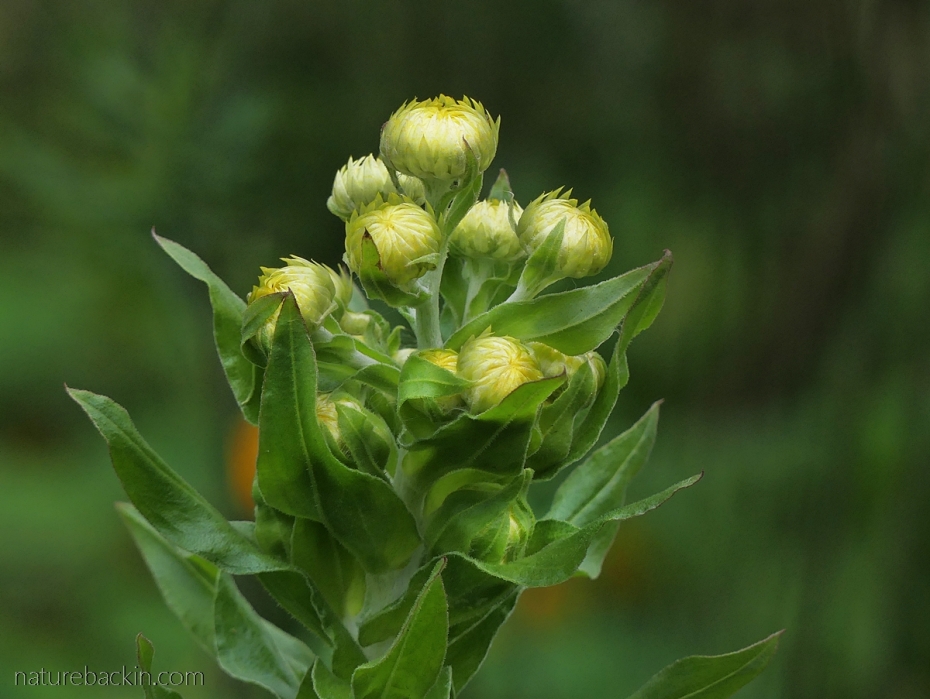
Currently sprouting up all around the garden, including in the lawn – they are grassland plants after all – are yellow everlasting (Helichrysum cooperi) plants. One of the tallest is just coming into flower. The flowers are everlastingly cheerful and pollinator attracting. Traditionally they have been used as love charms and the genus name derives from ‘helios’ meaning ‘sun’ and ‘chrysos’ meaning ‘gold’, in other words a complete treat.
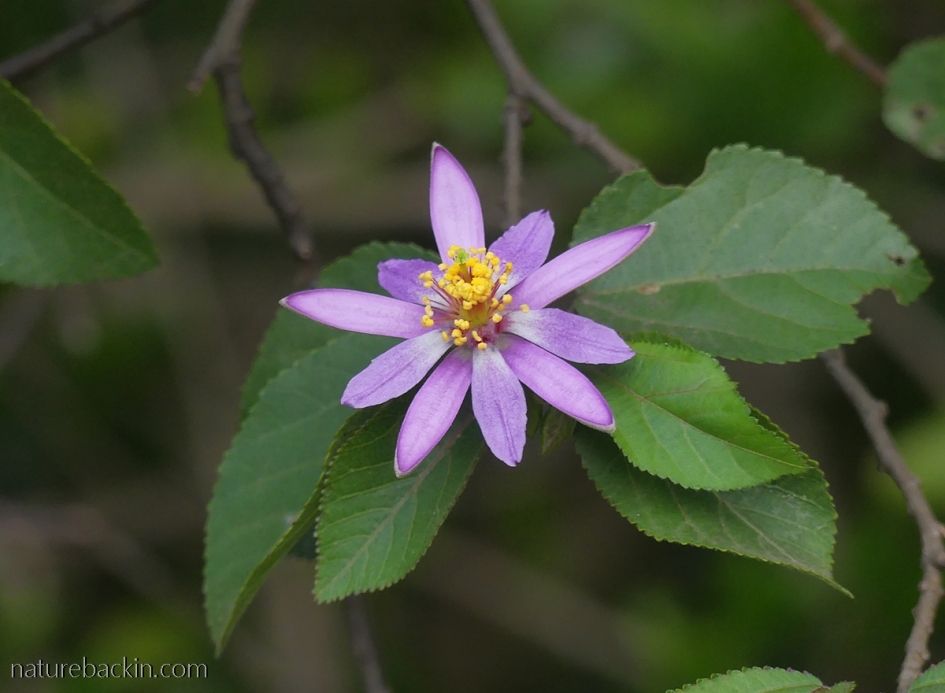
The Cross-berry (Grewia occidentalis) has featured often on naturebackin, and I can’t resist featuring it again with this flower photographed yesterday. Previously it has featured in other posts including as a host plant for processionary caterpillars, which attract caterpillar-eating birds such as the emerald cuckoo, and predatory insects such as the praying mantis. It has also featured incidentally as a nearby perching tree for nesting chorister robin-chats.
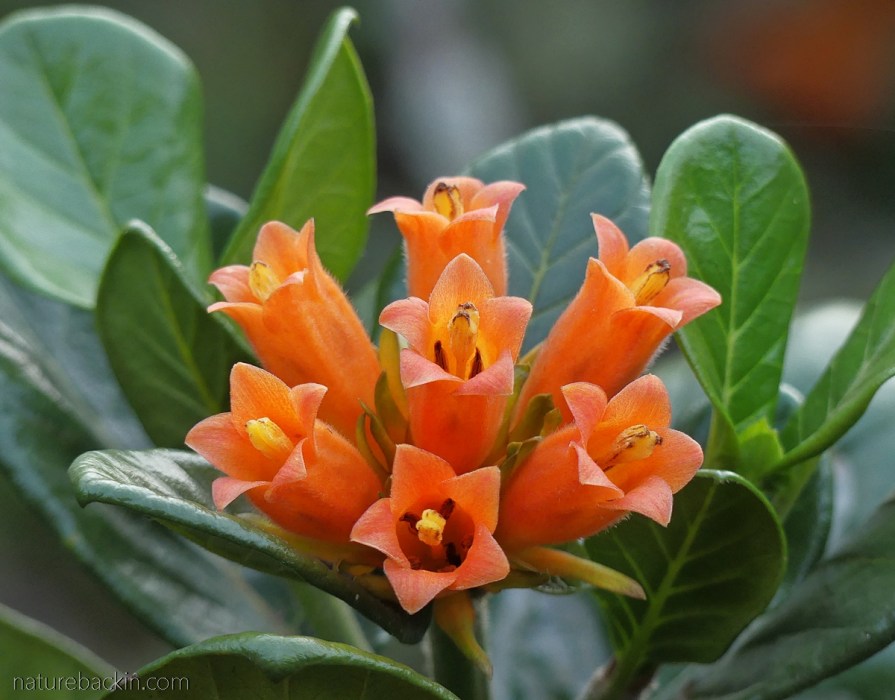
Also featured in the header photo is the natural posy formation of the small orange trumpet-shaped flowers of the wild pomegranate, (Burchellia bulbalina). This year has been a particularly fine season for prolific flowering – attracting many birds, especially sunbirds and sombre bulbuls, as well as many insect pollinators.
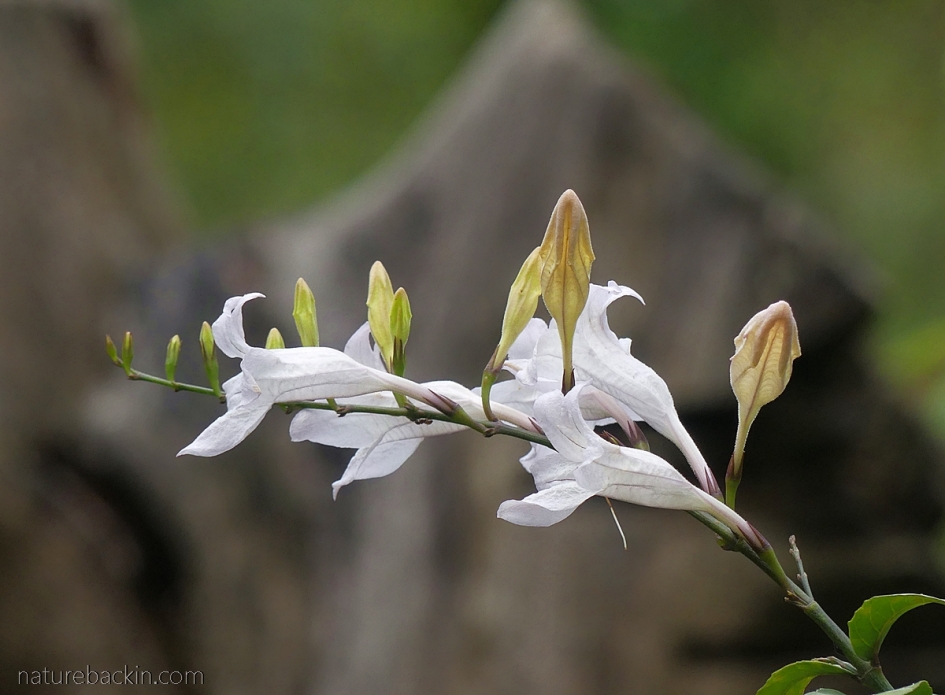
Known simply as Mackaya or as the Forest bell-bush, the shrubby Mackaya bella is currently coming into flower. The ‘bella’ part of the name means pretty, which it most definitely is.
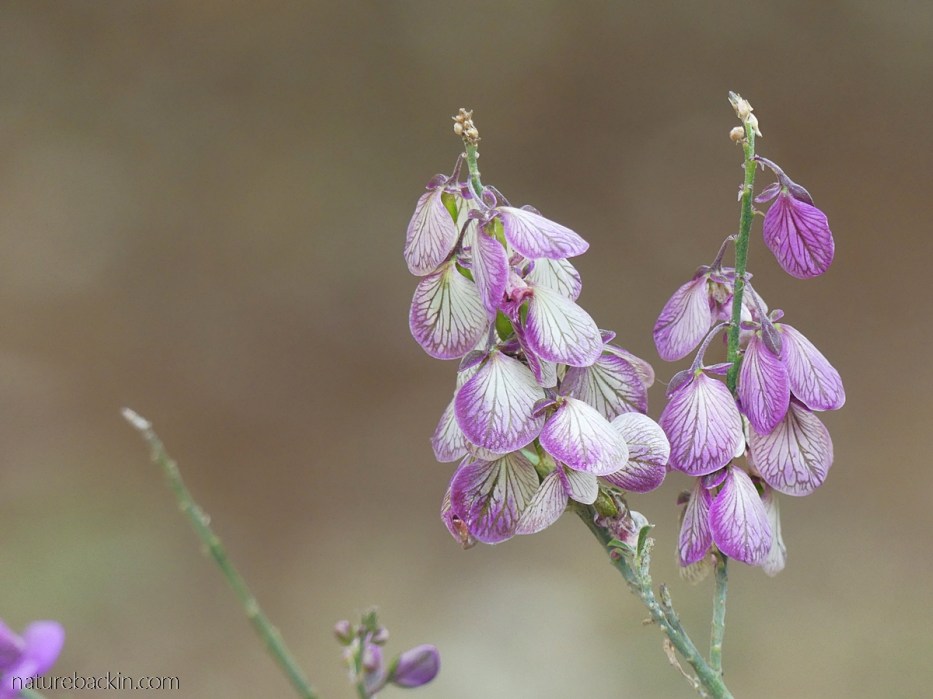
Another in the Polygala genus, the purple broom (Polygala virgata) is a tall slender plant that occurs naturally in grassland and along forest margins. ‘Virgata’ means ‘twiggy’ which is descriptive of the form of this plant. In the photo above the flowers are going over and fading in colour but showing rather lovely veining on the drooping petals.
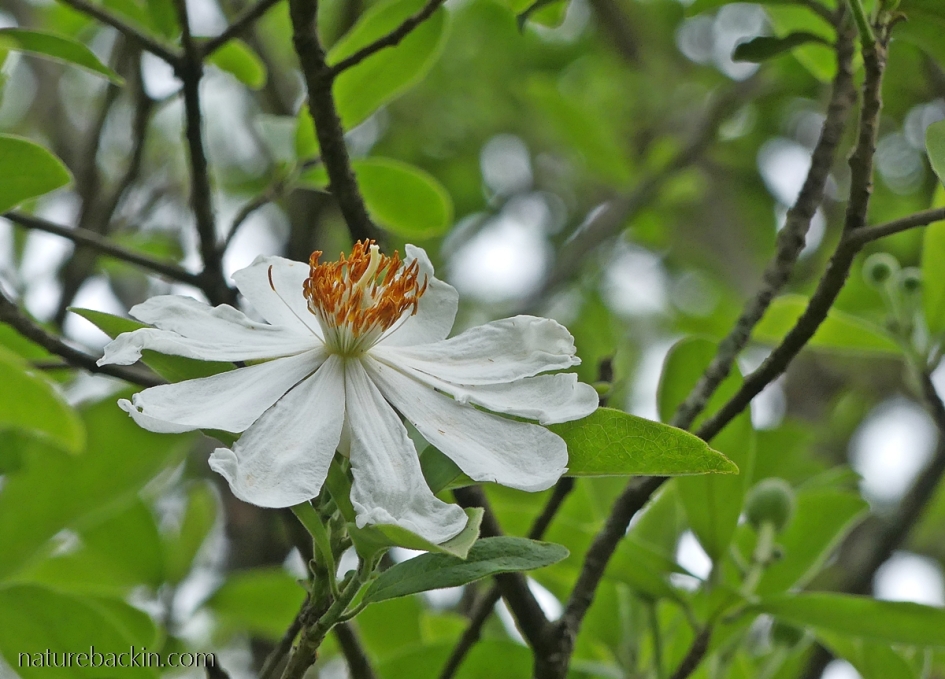
Above is a photo of one of the first flowers on our African dog rose (Xylotheca kraussiana) this spring. This lovely shrubby tree is a larval host plant of the blood red acraea butterfly.
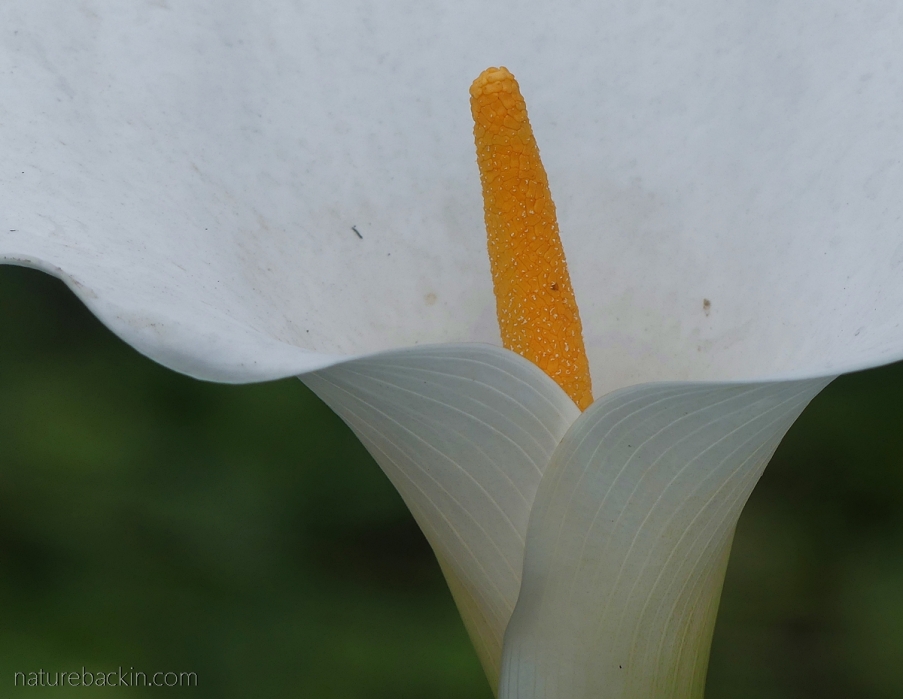
Known as arum lilies in South Africa and as calla lilies elsewhere Zantedeschia aethiopica are well known for the sculptural shape of the white spathe that surrounds the spadix and the unseen female flowers at the bottom of the spadix. The arum is another flowering plant featured before on naturebackin, including a photograph of a Natal forest tree frog (Leptopelis natalensis) nestling inside an arum, and fruit chafers pollinating the flowers in a post on dots and spots in nature. The flower in the photo, taken yesterday, is the first arum to flower in our garden this springtime.
P.S. My husband continues to recover, and this week after seeing another specialist obtained a more complete diagnosis and treatment plan, which is both a great help and a huge relief.
Posted by Carol

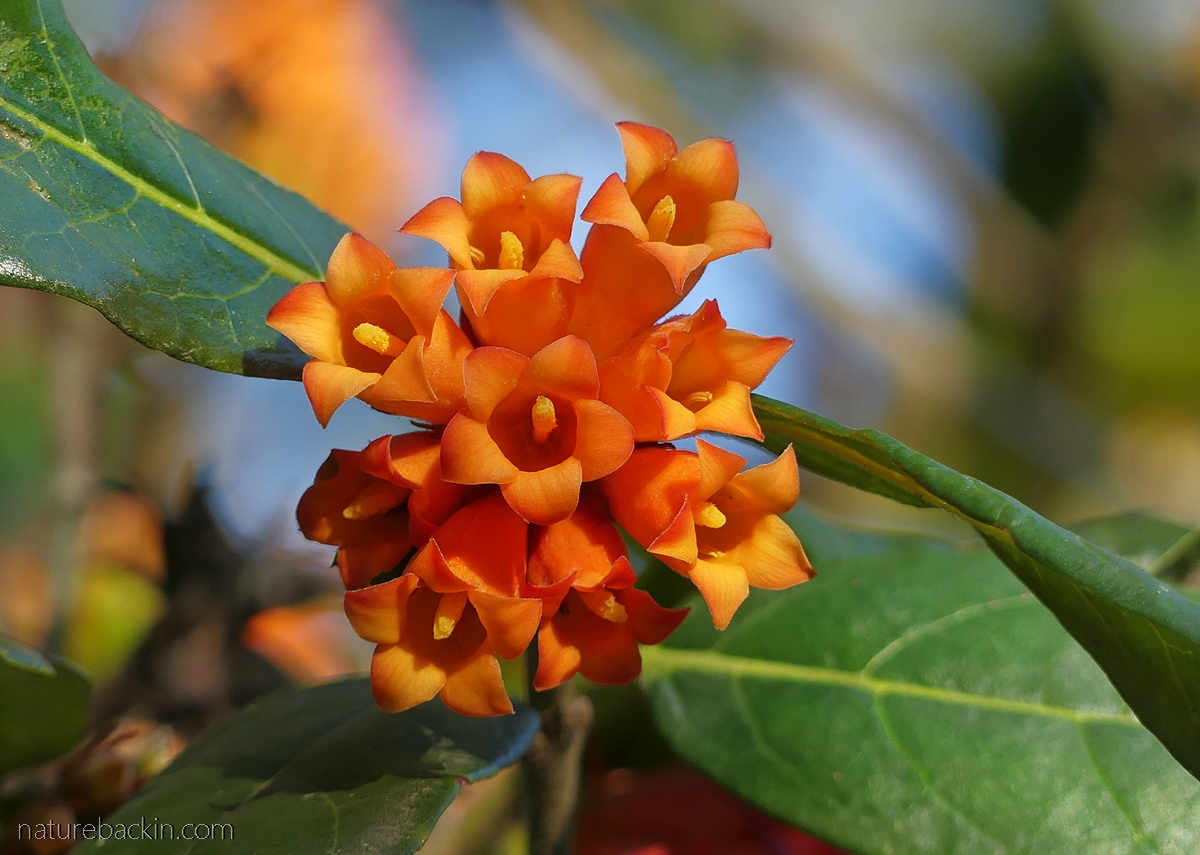







October 5, 2021 at 2:08 am
Such a treasure trove of beauty and hope, so pleased there is a good way forward for your husband! xxx
LikeLiked by 2 people
October 7, 2021 at 8:18 pm
Thanks Christeen – indeed there is something hopeful about spring flowers. My husband has made really good progress towards recovery this week.
xxx
LikeLiked by 1 person
October 5, 2021 at 1:14 am
Carol, this post is astonishing! What a wonderful garden you must have. Your delicate close-ups are so inviting, especially since I’m only familiar with a few of them.Thanks for lifting up my day!
Julie
LikeLiked by 2 people
October 7, 2021 at 8:17 pm
Thanks Julie. The spring blossoms certainly are uplifting, and so I am pleased to hear that the photos conveyed something of this too!
LikeLiked by 1 person
October 2, 2021 at 5:35 am
You have a lovely garden. What a great selection of flowers and such a nice way to welcome spring.
LikeLiked by 2 people
October 4, 2021 at 2:35 pm
Thanks Graham. Of course I don’t photograph the messy and neglected bits in the garden 🙂
But the spring blossoms are lovely. We are having really nice rain but accompanied by unusually cold weather. But I am afraid to wish for sunshine these days as that can lead to the opposite extreme of intense heat! So its best to make the most of whatever comes along that is not too extreme.
LikeLiked by 1 person
October 5, 2021 at 4:58 am
And regardless of what we wish for, the weather will do whatever the weather wants to!
LikeLiked by 1 person
October 7, 2021 at 8:19 pm
🙂
LikeLike
October 2, 2021 at 1:18 am
So many beautiful and delightful flowers– I love seeing all those new-to-me natives, thank you. 🙂
Glad to read that a recovery plan is in place for your husband… godspeed!
LikeLiked by 2 people
October 4, 2021 at 2:32 pm
Thank you Eliza, I enjoyed photographing the flowers to share. We are having a rather cool and rainy period extended over several days so I am glad I photographed the flowers when I did.
Thanks very much for your good wishes for my husband’s recovery. He has just had three days in a row feeling quite a bit better (the best days so far), which is great and very hopeful.
LikeLiked by 1 person
October 1, 2021 at 7:48 pm
I find it fascinating that your springtime is awakening while we head into our dormant phase. It’s such a pleasure to see your flowers. If I had to pick a favourite, the Plumbago is such a beautiful delicate blue, a relatively rare colour for flowers. We have calla lily volunteers popping up in the yard. Most likely introduced from someone’s garden. Not a favorite of mine since there’s this association with funerals. I think I caught a green tree frog perched in a calla lily at a previous house once. (Yes, I do seem to move around a lot! 🤨)
Good news of your husband’s continued recovery. It’s also good to see your posts again.
Wishing for continued progress! 🙏
LikeLiked by 2 people
October 4, 2021 at 2:29 pm
It is nice to have spring, but we are having an extended cool (almost cold by our standards with a maximum of 14 C (57 F) today) period. But the rain is most welcome.
The plumbago is a lovely delicate blue and the flowers are so shapely. Because we see arum (calla) lilies growing wild especially along water courses I have managed not to internalize the association with funerals. It seems tree frogs might have a particular liking for these lilies as we have seen that too.
Thanks for your good wishes. My husband has had three quite good days in a row, which is great. May this trend continue!
I hope you enjoy the fall even if it is ahead of the months of winter.
LikeLiked by 1 person
October 1, 2021 at 6:33 pm
What a beautiful bouquet!
LikeLike
October 1, 2021 at 7:36 pm
Thanks very much Mariss.
LikeLike
October 1, 2021 at 5:08 pm
That’s great news about your husband’s condition, Carol. Hopefully he will be moving forward with the new treatment plan. Meanwhile, thank you for this lovely post. I have much enjoyed studying the flowers, seeing how they connect with plants here. Coincidentally I have just bought a plumbago – a favourite of mine too and we have been without one since moving here five years ago.
LikeLiked by 1 person
October 1, 2021 at 7:33 pm
Thanks for the good wishes Sandra. Progress is very slow, but it is in the right direction re my husband’s health.
Enjoy your new plumbago. It is a larval host plant here for species of blue butterflies, so once it is in flower I guess that your plant will be the same.
LikeLiked by 1 person
October 1, 2021 at 2:50 pm
These are beautifully delicate photos of plants which in some cases seem to be quite the roughy-toughy. I’m glad your husband is proving resilient too. Onwards and upwards, we hope!
LikeLiked by 1 person
October 1, 2021 at 7:30 pm
Thanks Margaret. My husband continues to make slow progress with a couple of setbacks along the way. He is not feeling very resilient at the moment but hopefully tomorrow will be better. Thanks for the hopeful good wishes.
LikeLike
October 1, 2021 at 1:51 pm
Just gorgeous, Carol.
LikeLiked by 1 person
October 1, 2021 at 7:27 pm
Thanks very much, Sandy.
LikeLiked by 1 person
October 1, 2021 at 7:34 pm
My pleasure.
LikeLiked by 1 person
October 1, 2021 at 1:14 pm
I miss the lovely plants we had in Boughton.
LikeLiked by 2 people
October 1, 2021 at 7:27 pm
You did have a lovely garden. I hope that you manage to get some favourite plants to plant at the new place.
LikeLike
October 1, 2021 at 12:33 pm
You have a beautiful selection of spring flowers in your garden. The plumbago and clivias have come into bloom here, along with crossberries and bitou bushes. Glad to know you have a treatment plan. Enjoy your rain! We have enjoyed a day of very light drizzle – it’s amazing how everything responds to that.
LikeLiked by 2 people
October 1, 2021 at 7:25 pm
Hi Anne. Thanks. At least you had a day of light drizzle but obviously you need a lot more than that. It is good you have some spring flowers in the garden. Oddly only two of our clivias flowered this year, when usually they are all pretty reliable. Strange!
LikeLiked by 1 person
October 24, 2021 at 10:25 pm
You really do!!
LikeLiked by 1 person
October 26, 2021 at 6:40 pm
Thanks, yes we are very lucky 🙂
LikeLiked by 1 person